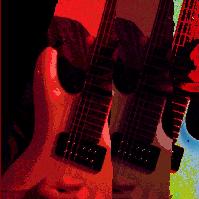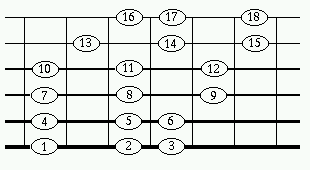
|
|
Guitar Lessons #2
Micro-sweeps
by Bill Majoros
11-20-2003
In the darkness of a smoky club somewhere outside Philly a guitarist
once showed me the secret to playing really fast fully-picked
scales. I don't remember the guy's name, but he was a really
great musician, and the hint he gave me that night permanently changed
the way I approached the guitar. Hey, buddy, if you're out
there... thanks!
In the previous installment of this series I showed part of an
anonymous minor key and how it lays out at a particular place on the
fretboard:

(figure 1)
Recall that the numbers inside the ovals depict the order in which you
would play this scale if you were to start at the root note and ascend
through all six strings. I showed you how to think of this
18-note run as no more than a conjoining of three patterns (Patterns A,
B, and C from Lesson #1) and I told you which fingers to use for each
of the notes in each of the three patterns.
The question is, how would you go about picking this sequence
of notes? Most guitarists will play something like this with
what's called alternate picking or cross-picking; i.e.,
down-up-down-up-down-up-...etc..., as shown below:

(figure 2)
In this tab-style illustration, the numbers indicate which fret to play
a given string on, and the v-shaped mark at the top indicates the
direction in which you would pick each note. A 'v' means to
down-pick, while a '^' means to up-pick.
The problem with cross-picking (and indeed, the reason it is called
cross-picking in the first place) is that when you go from one string
to the next you have to cross over a string with the pick (without
touching it!) before you can make the next stroke. For example,
in figure 2, after playing the third note (at fret 8 on the low
E-string) your pick will be moving downward, but you now have to pull
it away from the guitar, up and over the A-string, and then reverse
direction in order to up-pick the fourth note of the scale (at fret 5
on the A-string).
This is a lot of wasted movement. When you're trying to play
fast, you can't afford such waste. What's more, these types of
maneuvers are very error-prone -- it's very difficult to do this
perfectly without accidentally hitting the string you're trying to
cross over. Obviously, there are times when this type of movement
is unavoidable, and for that reason you need to practice your
cross-picking in order to do it well when necessity requires.
But many of these cross-over movements can in fact be eliminated, and
doing so will make it less likely that you will screw up somewhere
during a run by accidentally hitting a string you were trying to cross
over. You'll also conserve your muscular strength, which can help
you later in your solo, when your muscles are starting to feel tired
from the insane speed of your frantic picking.
So, how do you eliminate these cross-over maneuvers? Like this:

(figure 3)
If you look at the picking indicators up top, you'll see that they no
longer alternate strictly down-up-down-up anymore. Instead, they
go:
v ^ v v ^ v v ^ v v ^ v v ^ v v ...
where v means down and ^ means up. The two downs in a row
correspond to movement from one string to the next. These two
down-picks are actually one picking movement that goes through both
strings with one stroke. That's why I've placed those red arcs
above the down-picks in the figure.
When you play the scale in reverse, you do just the opposite --
whenever you move from one string to the next lower-pitched string, you
do it in one upward picking motion, so that you're effecting two
up-picks for every single down-pick:
...v ^ ^ v ^ ^ v ^ ^ v ^ ^ v ^ ^ v ^ ^ ...
These 2-string picking motions are called sweeps. I like to call
them micro-sweeps, because they only involve two notes
each. But whatever you call them, they save you a lot of picking
effort because you no longer have to cross over strings when picking a
run like the one in figure 3.
I found that when I switched to picking this way, my speed went up
dramatically. I had always had trouble playing fast scales like
Yngwie, but after I started using this trick I found that I could come
much closer to an Yngwie-like sound, and it didn't require a horrendous
amount of effort. I've read that Yngwie actually does do
cross-picking for runs like this, not the "micro-sweep" technique I've
showed you here, but in the time since I've learned this trick (14
years) I've never been able to think of a good reason not to use
micro-sweeping.
Unfortunately, this style of picking is difficult to get the hang of at
first. The difficulty lies in two areas:
- striking the string properly, and
- controlling your timing.
Regarding the first point, I found when I was starting out with this
technique that the two notes I played during the micro-sweep often
sounded twangy because I hadn't yet learned how to control how much
force I applied to each note in order to give the entire run a uniform
sound.
Much of this control actually comes from the way you hold your pick and
how you anchor your wrist or forearm. The pick I actually hold at
a slight angle to to the string -- that is, the flat of the pick does
not meet flush with the string, but rather, the leading edge of the
pick hits the string before the rest of the pick passes through
it. I think this actually smooths the sound a bit, but that's not
why I originally started picking that way -- I was really just trying
to accommodate this micro-sweeping strategy, and I found that striking
the string with the edge of the pick rather than the flat of it helped,
because when I tried to apply the flat of the pick to the string,
sometimes the pick would get sort of "stuck" on that string for just a
split second due to friction, and then when the force of my stroke
overcame that friction the string was released with an unnatural
"twang", and that didn't sound good. Holding the pick at a slight
angle solves this problem because there is far less friction, due to
the curvature of the pick.
The other major source of control is in the proper anchoring of your
wrist or forearm. I anchor my forearm against the guitar's body,
just above the low E-string. By doing this I'm able to exert more
force in my picking and tighten up my hand and wrist muscles in order
to achieve greater control. A limp picking hand is hardly under
control. You should be able to develop your picking-hand posture
so that all of your movements occur in short, controlled bursts.
As it turns out, all of these efforts for trying to control your
striking of the strings will also help your timing, because it's really
just another issue of control. You just need to listen to your
timing when you're practicing. The notes should sound at steady,
regular intervals. All of these techniques should at first be
played very slowly. At the beginning of each practice session I
used to start by playing scales exactly like the one shown in figure 3,
up the scale, then down the scale, then up the scale, then down the
scale... over and over, very slowly at first, then faster, and
faster.
I leave you with one more piece of advise that I read once (I think in
a Satriani interview or column) -- you should only play as fast as you
can play without making any mistakes. If you make a mistake while
you're practicing something, try it once more at that speed and if you
still can't get it right, then slow down. Do it perfectly at a
slower speed, and only then speed up. This is probably the best
guitar advice I've ever heard.
 ©2003
Bill Majoros.
All rights reserved. ©2003
Bill Majoros.
All rights reserved.
|
|
|

